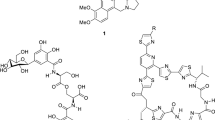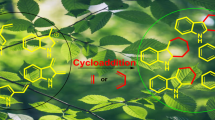Abstract
In our synthetic studies toward huperzine A, a diastereoselective α′-alkylation of the α-amido-γ-methyl hexenone 4 was realized through a dianion intermediate which significantly enhanced the reactivity. Under the attempted Heck reaction conditions, an unexpected and unprecedented palladium-catalyzed intramolecular γ-arylation of 3 was observed, which generated 18 with bicyclo[3.3.1]nonane framework in satisfactory yield.
Similar content being viewed by others
References
Liu J-S, Zhu Y-L, Yu C-M, Zhou Y-Z, Han Y-Y, Wu F-W, Qi B-F. The structures of huperzine A and B, two new alkaloids exhibiting marked anticholinesterase activity. Can J Chem, 1986, 64: 837–839
For the establishment of the identity of huperzine A with selagine, which was first isolated in 1960, see: (b) Ayer WA, Browne LM, Orszanska H, Valenta Z, Liu J-S. Alkaloids of Lycopodium selago. On the identity of selagine with huperzine A and the structure of a related alkaloid. Can J Chem, 1989, 67: 1538–1540
For reviews on the chemistry and biology of huperzine A, see: (a) Kozikowski AP, Tückmantel W. Chemistry, pharmacology, and clinical efficacy of the Chinese nootropic agent Huperzine A. Acc Chem Res, 1999, 32: 641–650
Bai D. Development of huperzine A and B for treatment of Alzheimer’s disease. Pure Appl Chem, 2007, 79: 469–479
Selected examples: (a) Qia LJR. A total synthesis of (±)-huperzine A. Tetrahedron Lett, 1989, 30: 2089–2090
Xia Y, Kozikowski A P. A practical synthesis of the Chinese “Nootropic” agent Huperzine A: A possible lead in the treatment of Alzheimer’s disease. J Am Chem Soc, 1989, 111: 4116–4117
Yamada F, Kozikowski AP, Reddy ER, Pang Y-P, Miller JH, McKinney M. A route to optically pure (−)-Hupuzine A: molecular modeling and in vitro pharmacology. J Am Chem Soc, 1991, 113: 4695–4696
Kozikowski AP, Campiani G, Aagaard P, McKinney M. An improved synthetic route to Huperzine A: New analogues and their inhibition of acetylcholinesterase. J Chem Soc, Chem Commun, 1993: 860–862
Kaneko S, Yoshino T, Katoh T, Terashima S. An enantioselective synthesis of natural (−)-Huperzine A via cinchona alkaloids-promoted asymmetric Michael reaction. Heterocycles, 1997, 46: 27–30
Kaneko S, Yoshino T, Katoh T, Terashima S. A novel enantioselective synthesis of the key intermediate of (−)-huperzine A employing asymmetric palladium-catalyzed bicycloannulation. Tetrahedron Asymm, 1997, 8: 829–832
Kaneko S, Yoshino T, Katoh T, Terashima S. Synthetic studies of Huperzine A and its fluorinated analogues. 1. Novel asymmetric syntheses of an enantiomeric pair of Huperzine A. Tetrahedron, 1998, 54, 5471–5484
Chassaing C, Haudrechy A, Langlois Y. Asymmetric palladium annulation: formal synthesis of (+)-huperzine A. Tetrahedron Lett, 1999, 40: 8805–8809
Haudrechy A, Chassaing C, Riche C, Langlois Y. A formal synthesis of (+)-Huperzine A. Tetrahedron, 2000, 56: 3181–3187
He X-C, Wang B, Yu G, Bai D. Studies on the asymmetric synthesis of huperzine A. Part 2: Highly enantioselective palldium-catalyzed bicycloannulation of the β-keto-ester using new chiral ferrocenylphosphine ligands. Tetrahedron Asymm, 2001, 12: 3213–3216
Lee IYC, Jung MH, Lee HW, Yang JY. Synthesis of huperzine intermediates via Mn(III)-mediated radical cyclization. Tetrahedron Lett, 2002, 43: 2407–2409
Pan Q-B, Ma D-W. Chiral guanidine catalyzed annulation to the core structure of (−)-Huperzine A. Chin J Chem, 2003, 21: 793–796
Ward J, Caprio V. A radical mediated approach to the core structure of huperzine A. Tetrahedron Lett, 2006, 47: 553–556
Lucey C, Kelly SA, Mann J. A concise and convergent (formal) total synthesis of huperzine A. Org Biomol Chem. 2007, 5: 301–306
Ward J, Caprio V. Synthesis of the bicyclo[3.3.1]nonane core of Huperzine A and novel pyridine-fused tricycles by cyclisation of pyridine-based radicals. Heterocycles, 2009, 79: 791–804
Koshiba T, Yokoshima S, Fukuyama T. Total synthesis of (−)-Huperzine A. Org Lett, 2009, 11: 5354–5356
Sun B-F, Wang C-L, Ding R, Xu J-Y, Lin G-Q. Concise approach to the core of englerin A via an organocatalytic [4+3] cycloaddition reaction. Tetrahedron Lett, 2011, 52: 2155–2158
Sun B, Xu X. Stereospecific rearrangement of α-hydroxyepoxide: efficient approach to the trans-bicyclo[9.3.0]tetradecane core en route to clavulactone. Tetrahedron Lett, 2006, 47: 299–302
Sun B, Xu X. General synthetic approach to bicyclo[9.3.0]tetradecenone: A versatile intermediate to clavulactone and clavirolides. Tetrahedron Lett, 2005, 46: 8431–8434
Mann et al. had employed a similar strategy on a different substrate in their racemic formal synthesis of huperzine A. See ref. [3n]
For an excellent example of traceless stereochemical guidance, see: Zhang Y, Danishefsky SJ. Total synthesis of (±)-Aplykurodinone-1: Traceless stereochemical guidance. J Am Chem Soc, 2010, 132: 9567–9569
Avery MA, Chong WKM, Jennings-White C. Stereoselective total synthesis of (+)-artemisinin, the antimalarial constituent of Artemisia annua L. J Am Chem Soc, 1992, 114: 974–979
For a review on β-iodo carbonyl compounds in Pd-catalyzed cross-coupling reactions, see: Negishi E. Novel and selective α-substitution of ketones and other carbonyl compounds based on Pd-catalyzed cross coupling of α,β-unsaturated carbonyl derivatives containing a-halogen or α-metal groups. J Organomet Chem, 1999, 576: 179–194
Guram A. S, Rennels RA, Buchwald SL. A simple catalytic method for the conversion of aryl bromides to arylamines. Angew Chem, Int Engl, 1995, 34: 1348–1350
Louie J, Hartwig JF. Palladium-catalyzed synthesis of arylamines from aryl halides. Mechanistic studies lead to coupling in the absence of tin reagents. Tetrahedron Lett, 1995, 36: 3609–3612
For a copper-catalyzed Buchwald coupling reaction using α-iodo-α,β-unsaturated ketone as the substrate, see: (a) Focken T, Charette AB. Stereoselective synthesis of pyridinones: application to the synthesis of (−)-Barrenazines. Org Lett, 2006, 8: 2985–2988
For relevant reactions employing aryl triflates, see: (b) Hicks FA, Brookhart M. Synthesis of 2-anilinotropones via palladium-catalyzed amination of 2-triflatotropone. Org Lett, 2000, 2: 219–221
Farard J, Logé C, Pfeiffer B, Lesur B, Duflos M. A convenient synthesis of 5-arylamino-4H-pyran-4-ones using palladium-catalyzed amination. Tetrahedron Lett, 2009, 50: 5729–5732
Kelly SA, Foricher Y, Mann J, Bentley JM. A convergent approach to huperzine A and analogues. Org Biomol Chem, 2003, 1: 2865–2876
The stereochemistry was elucidated via the X-ray structure of 17 obtained through the addition reaction of 14 with Grignard reagent
For examples of N,C-dianion alkylations, see: (a) Thompson ME. α,N-alkanesulfonamide dianions: formation and chemoselective C-alkylation. J Org Chem, 1984, 49: 1700–1703
Watanabe H, Hauser CR. Metalation at methyl group of N-substituted o-toluenesulfonamides by excess n-butyllithium. condensation with benzophenone. J Org Chem, 1968, 33: 4278–4279
Lee J, Zhong Y-L, Reamer RA, Askin D. Practical synthesis of sultams via sulfonamide dianion alkylation: Application to the synthesis of chiral sultams. Org Lett, 2003, 5: 4175–4177
See Supporting Information for details
For an alternative access to 1-methylbicyclo[3. 3.1]nonane skeleton via a Mn(III)-based oxidative free radical cyclization, see: Snider B. B, Cole BM. Mn(III)-based oxidative free radical cyclization of unsaturated ketones. J Org Chem, 1995, 60: 5376–5377
We reasoned that if racemization was intervening, α′-epi-3 should also be capable of generating 18. This was exactly what we observed. When α′-epi-3 3 was subjected to the identical reaction conditions, product 18 was obtained in comparable yield
For selected examples, see: (a) Liu Y, Li D, Park C-M. Stereoselective synthesis of highly substituted enamides by an oxidative Heck reaction. Angew Chem, Int Ed, 2011, 50: 7333–7336
Zhang H, Ferreira EM, Stoltz BM. Direct oxidative Heck cyclizations: Intramolecular Fujiwara-Moritani arylations for the synthesis of functionalized benzofurans and dihydrobenzofurans. Angew Chem, Int Ed, 2004, 43: 6144–6148
Garg NK, Caspi DD, Stoltz BM. The total synthesis of (+)-dragmacidin F. J Am Chem Soc, 2004, 126: 9552–9553
Author information
Authors and Affiliations
Corresponding authors
Electronic supplementary material
Rights and permissions
About this article
Cite this article
Ding, R., Lu, Y., Yao, H. et al. A new approach to the bicyclo[3.3.1]nonane framework of huperzine A-like molecules via palladium-catalyzed intramolecular γ-arylation. Sci. China Chem. 55, 1097–1100 (2012). https://doi.org/10.1007/s11426-011-4480-y
Received:
Accepted:
Published:
Issue Date:
DOI: https://doi.org/10.1007/s11426-011-4480-y




